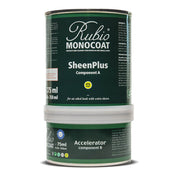How does a polyurethane wood finish compare to a hardwax oil wood finishing product? Today we dive into the differences between the products.
Perhaps you're not familiar with them yet and want to read more about what a hardwax oil actually is.
As we compare the differences, the following topics will be covered:
- Film Build & Aesthetic Appearance
- Colors
- VOC Levels
- Number of Coats Required
- Protection
- Repairability
- Cleaning
- Maintenance
Film build – Aesthetic Appearance
Hardwax oil
Hardwax oil finishes do not building up a layer of film on the surface. This allows hardwax oil finished wood to keep a very natural finished wood surface without obscuring the touch and visibility of the grain. The sheen of hardwax oil is typically matte, with some products able to achieve increased sheen.
Polyurethane
A polyurethane finish builds up multiple layers on top of the wood surface. This results in a synthetic/plastic-like film. The layers of film refract light and gives a shiny or glossy appearance. Polyurethanes come in varying sheen levels including matte, however due to build up, matte polyurethanes appear different than hardwax oils.
Conclusion
Subjective. This category depends on the look you are trying to achieve. Hardwax oils are a great option if you are looking for a matte finish that keeps both the natural look and feel of the wood. Polyurethanes are great if you want an increased sheen and prefer less texture to the floor.
The trend in recent years is a natural-appearing finish that complements the character of the wood. Preference for matte sheen finishes has been steadily increasing over the past few years.
Colors
Hardwax oil
The technology of hardwax oils allows pigment to be added directly to the product. This allows for the addition of color during the finishing process without adding an additional step in the process, saving a significant amount of time. Manufacturer approved stains, or “pre-colors”, may also be used prior to finishing with a colored hardwax oil, allowing for cerused looks and expanded creativity. Hardwax oils highlight the natural characteristics of the wood. If the surface is not prepped properly, colored oils can highlight imperfections in the surface preparation.
Polyurethane
When a polyurethane project requires adding color, this is typically achieved by staining the surface prior to applying the polyurethane. Stains typically require a skilled hand to apply due to their tendency to show lap marks. Staining also means an additional step and extra time in the finishing process.
Conclusion
Hardwax oils offer the advantage of applying color during the finishing process. This can save a significant amount of time and labor during the finishing stages, though it should be mentioned that prepping for hardwax oils requires proper sanding skills.
VOC Levels
Hardwax Oil
Many hardwax oil finishes have high solid content, meaning they contain less solvent to evaporate and therefore, less VOCs are emitted. Many contain small amounts while some contain 0% VOC levels.
Polyurethane
Polyurethanes use solvents or water as a carrier. Those that use solvents have higher levels while those that use water have inherently lower levels. VOC levels are regulated by legislation at both the federal and state level. Polyurethane VOC content can be as high as 550g/L and require ventilation and respirators. Some 0% VOC water-based polyurethanes are available.
Conclusion
Modern advances in technology have lessened the dependency on VOCs. This has led to the availability of low and 0% VOC options. VOCs impact the person applying them, the end-user, and the environment. Therefore, when choosing the amount of VOC you want in your finish, you need to keep all these factors in mind. Additionally, individuals with chemical sensitivities may be affected by VOC vapors and require the use of 0% VOC products.
Number of coats – simplicity of application
Hardwax Oil
Most hardwax oil wood finishes only require a single application, while some require additional applications.
Hardwax oil wood finishes are typically very simple and easy to apply. Most hardwax oil wood finish products get applied, worked in, and finished with an electric buffing tool or are ‘hand-rubbed” on smaller wood finishing projects. Excess oil is typically completely removed with absorbing rags. So, one does not ever need to worry about hairs, dirt, and debris in the finish.
Polyurethane
Most polyurethane wood finishes require a minimum of 3 coats as a recommended wood protection system.
All polyurethanes require multiple steps to complete the finishing stage. Most polyurethanes require good abrasion between applications to get proper adhesion and to achieve a smooth substrate free of debris and dust in the finish. They also require a sterile environment and “craftsman-like” application skills to achieve a professionally appearing finish that is free of dirt and debris in the finish coat.
Conclusion
The ease of application and time savings provided by hardwax oil wood finishes are apparent when compared against polyurethane.
Protection
Hardwax oil
The protection in hardwax oil results from the oil and wax formula in the product. Due to the wax, liquids bead up on the surface and make for easy cleaning. Most hardwax oils will harden the surface slightly, however, the final hardness of the finished surface is dependent on the wood species used. Due to the low-sheen, light scratches on the surface are not easily visible.
Hardwax oil wood finishes allow more stability when working with wider planks, particularly for flooring. The water vapor transmission is more controlled and consistent due to the absence of the film build like with a polyurethane finish. In other words, the wood acclimates easier and is more controlled to variations in relative humidity (RH) with less undesirable movement.
Polyurethane
Polyurethane achieves its protection through building up layers of synthetic/plastic material above the wood surface. Because of the thick film build, polyurethane takes longer to be affected by chemicals and liquids. Light scratches on the surface are accented by light refracting in the build layer.
The thick film created by polyurethane may pose some issues when applied to a wood surface like wide plank flooring or a tabletop in environments that are exposed to widely varying relative humidity levels. When just one side of the wood surface is finished with a thick film, if there is a significant fluctuation in RH, often the exposed wood substrate may experience undesirable movement like cupping or crowning. The finished side of that wood substrate controls the transmission of moisture vapor more than the unfinished side or less thick finished side, resulting in undesirable wood movement.
Conclusion
Both finishes allow liquids to bead up for easy cleaning. Polyurethane will provide protection against liquids and chemicals longer than hardwax oil finishes, however, this is accomplished using a plastic film on the surface which will show scratches much more easily than hardwax oil. Next, we will discuss repairability.
Repairability
Hardwax Oil
Hardwax oil is accepted into the wood and once the wood accepts it, no additional product is accepted. This technology allows for localized spot repair. Areas or spots can be fixed by repairing the area and re-introducing oil to just that area. The wood will only take the oil as needed, leaving a consistent look across the floor. Depending on the repair process, the sheen may be slightly different until the surface has fully cured and been used and cleaned a few times.
Polyurethane
Repairing wear or damage on a polyurethane finished wood substrate requires a lot of time to apply the multiple layers and a significant amount of skill to blend or feather the finish in with the surrounding finish. If the floor was stained it adds another level of complexity. Often, it is so difficult to spot repair polyurethane that the entire surface needs to be re-sanded and re-finished.
Conclusion
Hardwax oil allows for significantly easier repairs compared to polyurethane finish, which often requires a complete re-sand and re-finish.
Cleaning
Hardwax Oil
Most manufacturers recommend general cleaning by dusting, vacuuming, and damp cleaning using water or a cleaning solution. Each manufacturer recommends a specific cleaner. Using the wrong cleaner may affect the protection and performance of the applied hardwax oil finish, cutting down on the life of the surface.
Many recommended cleaners may contain some type of oil in the soap formulation to nourish the oiled substrate during the cleaning.
Polyurethane
Most polyurethane manufactures also recommend general cleaning by dusting, vacuuming, and damp cleaning using water or a cleaning solution. The use of specific cleaners is less important for a polyurethane floor.
Conclusion
If you are using approved cleaners, care for both finishes are very similar.
Maintenance
Hardwax Oil
Since there is no film build with a hardwax oiled wood finish, some maintenance is required to maintain the protection and beauty of the oiled wood substrate. Maintenance frequency will depend on use, climate, and cleaning process. The periodic reoiling (aka refreshing or renewing), is easy to perform and does typically not require abrasion to be performed during that process. Simply apply the recommended maintenance product to the needed areas. This reoiling may be performed in localized areas without the need to refresh or renew the entire floor, and rugs and furniture do not need to be removed. Simply work around it.
Most surface scratches are resolved during maintenance. If maintenance is not done from time to time, the aesthetic and protection will be affected.
Polyurethane
Periodically, depending on use and cleaning process, a polyurethane finished wood surface will require a "buff and coat." This involves the removal of all furniture, abrasion of the entire surface, and a coat of more polyurethane. Abrading the surface introduces dust into the environment and increases the risk of surface contamination in the applied maintenance coat.
The "buff and coat" process will usually highlight any surface scratches in the surface. Again, if maintenance is not done from time to time, the aesthetic and protection will be affected.
Conclusion
While both products will require maintenance, hardwax oil may require it slightly more frequent than a polyurethane, however, hardwax oil maintenance is much easier to perform and can be done quicker than polyurethane maintenance. The consideration should be whether minor (no sanding, no furniture removal) maintenance at a slightly more frequent interval or major maintenance (abrasion, dust, and furniture removal) less frequently is preferred.

